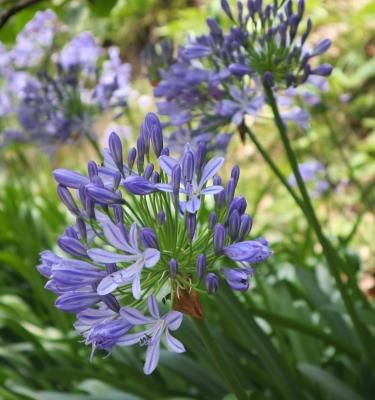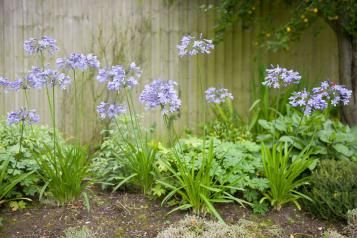

How to plant and care for agapanthus in Australia
Beloved in coastal gardens, agapanthus are known for their stunning blue or white flowers. These hardy perennials are perfect for adding vibrant colour to garden beds, pathways, or containers. Good news for gardeners across Australia: you can grow agapanthus successfully with the right care, even in pots!
Here’s your step-by-step guide to planting and maintaining agapanthus plants.
Popular types of agapanthus
Agapanthus (also known as African lily plants or Lily of the Nile) are bulbous perennials from the Amaryllidaceae family, boasting evergreen or semi-evergreen foliage. Their striking flower stalks rise above ribbon-like leaves, forming vibrant blue, violet, or white blooms.
Agapanthus thrive in warm climates but aren’t frost-resistant and should be protected from temperatures below -5°C.
Here are some standout agapanthus varieties in Australia:
-
Agapanthus Ozbreed® series – Bingo Blue™, Bingo White™, Buccaneer™ (sterile, repeat-flowering, hardy).
-
Agapanthus Queen Mum – striking blue and white bicolour.
-
Agapanthus Black Pantha – dramatic dark purple blooms.
-
Agapanthus Silver Baby – compact, pale blue fading to white.
-
Agapanthus Snowball – dwarf pure white form.
-
Agapanthus Peter Pan – compact, reliable blue flowers.
-
Agapanthus Strawberry Ice Pink – soft pink blooms for contrast.
When to plant agapanthus
Agapanthus bulbs or plants can be planted year-round, although it’s generally recommended to plant them in early spring (September to October) to enjoy their flowers by mid-summer. In warmer climates, planting can start earlier, around late winter. Avoid planting during frosty periods, as the roots are sensitive to cold.

Planting agapanthus in containers
For areas prone to frost or limited garden space, growing agapanthus in pots is a great option. Here’s how:
-
Choose a container with drainage holes to prevent waterlogging.
-
Fill the pot with a mix of potting soil and coarse sand or grit for excellent drainage.
-
Gently loosen the plant’s roots and place it in the container. Fill the remaining space with soil, ensuring the root crown sits just below the soil surface.
-
Water generously after planting.
How to grow agapanthus from seed
Planting agapanthus seeds can be a rewarding way to grow these beautiful flowering plants. Here's a step-by-step guide on how to plant agapanthus seeds:
-
Collect agapanthus seeds from dried flower heads.
-
Sow the seeds in a pot in well-draining soil. Scatter the seeds on the surface and cover them with a very thin layer of potting mix (no more than 5 mm).
-
Maintain consistent moisture by misting the soil when it begins to dry out. Avoid waterlogging.
-
Once the seedlings have grown, transplant them into individual pots or directly into the garden in a sunny spot. Wait until the plants have grown a few leaves and are sturdy enough to handle before transplanting agapanthus.
-
Keep the soil moist as the plants establish themselves and protect young plants from extreme weather.
Where to plant agapanthus
Agapanthus thrive in sunny, well-drained locations. While full sun is ideal, they can tolerate partial shade as long as the soil remains fresh and moist.
In the garden:
-
Select a spot with protection from strong winds to prevent flower stalks from bending or breaking.
-
Use rich, well-draining soil to avoid root rot caused by waterlogged conditions.
In pots:
-
Place pots in a sunny location. Avoid southern exposures where the lack of light can hinder growth. For shaded balconies, consider alternative plants like begonias or impatiens.
Companion planting with agapanthus
Agapanthus flowers look stunning both on their own and as part of a mixed garden design. Here are some ideas for pairing them with other plants:
-
Shrubs: Complement their tall, elegant flower stalks with low-growing shrubs like Choisya (Mexican orange blossom) or Caryopteris.
-
Annuals: Add a cottage garden feel by pairing with vibrant annuals, which can also be cut for floral arrangements.
-
Grasses: For a light, breezy effect, plant agapanthus alongside ornamental grasses like Stipa or Miscanthus.
-
Tall perennials: Combine with sunflowers, canna lilies, or Gaura for a dynamic display.
-
Borders and pathways: Use agapanthus to line a path or wall, creating a chic, coastal vibe.
Agapanthus plant care tips
Garden agapanthus plants
-
Watering: Water once a week during the main growing period. Otherwise, only water during extended dry periods.
-
Fertilising: Apply a fertiliser designed for flowering plants before the blooming season for lush flowers.
-
Deadheading: Remove faded flowers to encourage further blooms and keep the plant tidy.
-
Winter care: In cooler regions, cut stems back to ground level after blooming and cover with thick mulch to protect against frost.
-
Dividing clumps: Large clumps may inhibit flowering. In autumn or early winter, use a sharp knife to divide them into smaller sections. Replant to rejuvenate growth and create new plants to share.
Potted agapanthus plants
-
Watering: During the hottest parts of summer, water potted agapanthus 1–2 times a week, ensuring the soil remains moist but not waterlogged.
-
Fertilising: Use a flowering plant fertiliser, similar to those used for geraniums, to encourage abundant blooms. Apply during the growing season.
-
Winter care: Move pots to a cool, sheltered location during winter. For mild winters, cover the plants with frost cloth instead.
How to prune agapanthus
Trimming agapanthus is an essential task to maintain the plant's health, encourage blooming, and keep it looking tidy. Here's how to do it:
-
Prune after flowering: Once the flowers fade, cut back the spent flower stems to the base of the plant. This prevents the plant from putting energy into seed production and encourages more blooms in the future.
-
Prune in late winter or early spring: The best time for cutting back agapanthus is before new growth appears. This helps prepare the plant for the growing season.
-
Remove dead or damaged leaves: Inspect the plant for yellow, brown, or damaged leaves. Use sharp, clean pruning shears to cut these leaves back to the base of the plant.
-
Be gentle with evergreen varieties: If you have an evergreen variety of agapanthus, avoid cutting back all the foliage, as it supports the plant's growth. Focus on removing only dead or damaged parts.
-
Dispose of agapanthus prunings properly: Always discard pruned materials in the compost or green waste bin to prevent pests and diseases from spreading.
Common agapanthus pests and diseases
Agapanthus are generally hardy but can be affected by a few pests and conditions:
-
Root rot: Caused by overwatering or poor drainage. Always empty saucers under pots and avoid waterlogging.
-
Slugs and snails: These pests can damage young shoots. Use snail and slug repellents or create physical barriers around plants.
-
Grey mould (botrytis): High humidity can lead to mould on leaves or flowers. Remove affected parts and ensure proper airflow around plants.
Key tips for growing agapanthus
-
Light: Choose a sunny spot for vibrant blooms, with some protection from wind.
-
Soil: Use rich, well-draining soil to prevent waterlogging and root rot.
-
Watering: Adjust watering based on location – less in the garden, more in pots during summer.
-
Fertiliser: Apply a flowering plant fertiliser for robust, colourful blooms.
-
Winter care: Mulch garden plants or shelter potted ones during colder months.
With these tips, your agapanthus will thrive, bringing bold colours and elegance to your garden or patio for years to come.
Frequently asked questions
Are agapanthus poisonous to dogs and cats?
Yes, agapanthus plants can be toxic if ingested by dogs, cats, and other pets.
When do agapanthus bloom?
Agapanthus typically bloom from late spring through summer, depending on the climate and variety.
Can I grow agapanthus from seeds?
Yes! Collect agapanthus seeds from dried flower heads, then sow them in well-draining soil. Note that seed-grown plants may take a few years to flower.
Are agapanthus ‘weedy’ or invasive?
Yes! Agapanthus may be a declared weed in your area. Check with local authorities before planting or make sure those you plant are sterile hybrids that don’t set seeds. If in doubt, don’t plant or cut off spent flower heads before they die off and produce seeds. Never discard plants on roadsides or in bushland – dispose of unwanted plants responsibly




